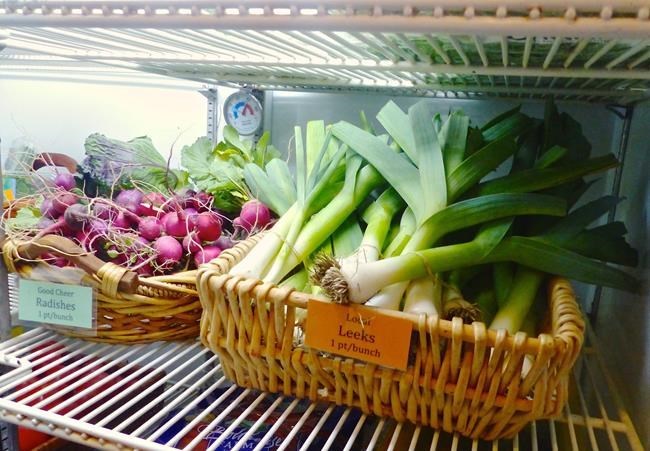
This photograph taken April 29, 2016, at The Good Cheer Food Bank near Langley, Washington, shows just-picked produce available to people living on the southern end of Whidbey Island. A monthly point system is assigned to clients based on the number of people in their family. Healthier eating habits are encouraged by assigning low point values to fresh fruits and vegetables and a higher number of points to processed foods. (Dean Fosdick via AP)
May 31, 2016 - 6:28 AM
Gardening can be especially rewarding when some of the harvest is given to charity. Contributing just-picked fruits and vegetables not only alleviates hunger but helps develop healthier eating habits.
Nearly 50 million Americans worry about where their next meal is coming from, said Roger Doiron, founding director of Kitchen Gardeners International. His organization encourages charitable garden ventures across the country by, among other things, offering small grants and funding tools through a program called SeedMoney.
"Donated produce, whether it was grown in a home garden or public garden, has an important role to play in this," Doiron said. "Many of these giving-garden projects, such as church gardens or community gardens, offer other societal benefits, such as safe community garden spaces and healthy forms of recreation."
Numerous public and private food-assistance groups have sprouted up, from the federal Supplemental Nutrition Program for Women, Infants and Children; to Feeding America; Ample Harvest; and Plant a Row for the Hungry, the latter a creation of the Garden Writers Association.
"If every gardener plants one extra row of vegetables and donates their surplus to local food agencies and soup kitchens, a significant impact can be made on reducing hunger," according to the Plant a Row website, which estimates that more than 84 million U.S. households have yards or gardens.
What to give? Agencies recommend contributing the most common fruits and vegetables, many of which are among the easiest for children to grow at home or at school.
That includes leaf lettuce, peas, carrots, tomatoes, onions and radishes, along with many fruits and herbs. The list may vary by location, so check with a local food bank to see what they can use.
"We want our food bank to look like a store," said Kathy McCabe, executive director of Good Cheer Food Bank & Thrift Stores near Langley, Washington. "We believe in choice. We let clients make the decisions about managing their budgets and diets."
The Good Cheer Food Bank provides foodstuffs, hot soup, and basic items like toilet paper and soap for people living on the southern portion of Whidbey Island.
"You can't measure need, which is pretty consistent throughout the year," McCabe said. "The only thing we ask is that they live on South Whidbey so we're not competing with other food banks on the island. But even then, we don't let them leave hungry."
___
Online:
For more about garden giving and finding a local food bank, see this Feeding America website: www.feedingamerica.org/find-your-local-foodbank
You can contact Dean Fosdick at deanfosdick@netscape.net
News from © The Associated Press, 2016